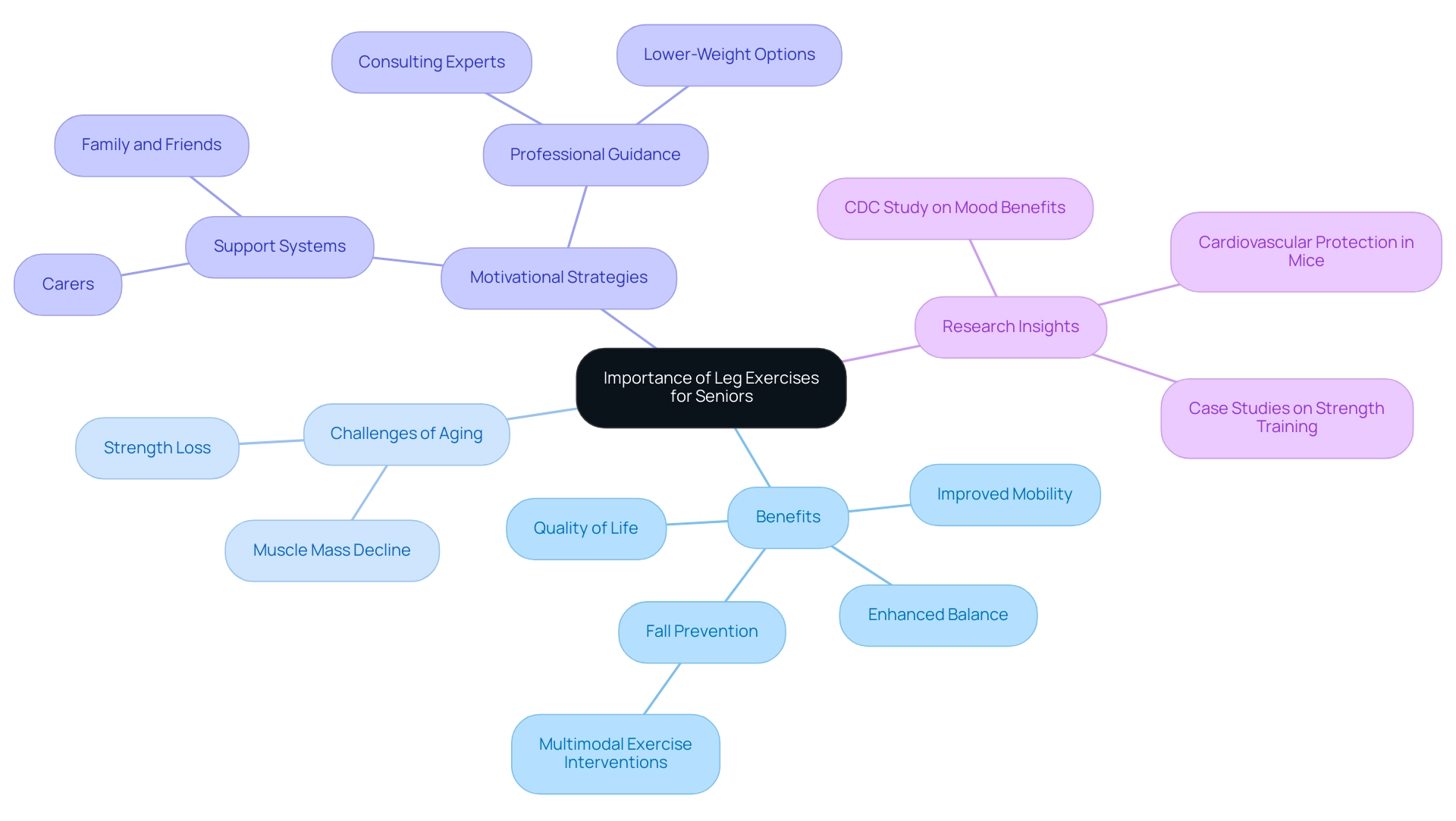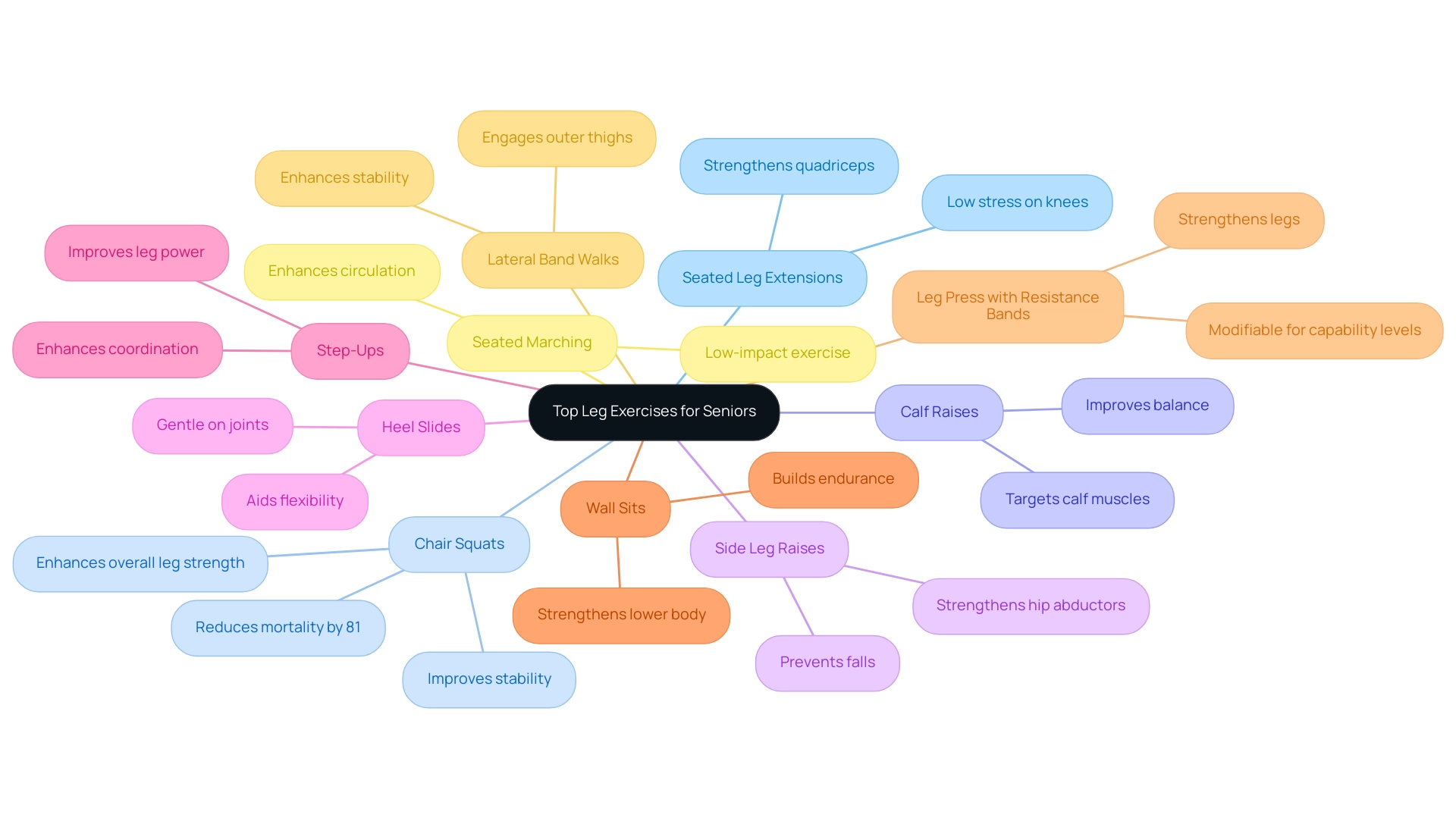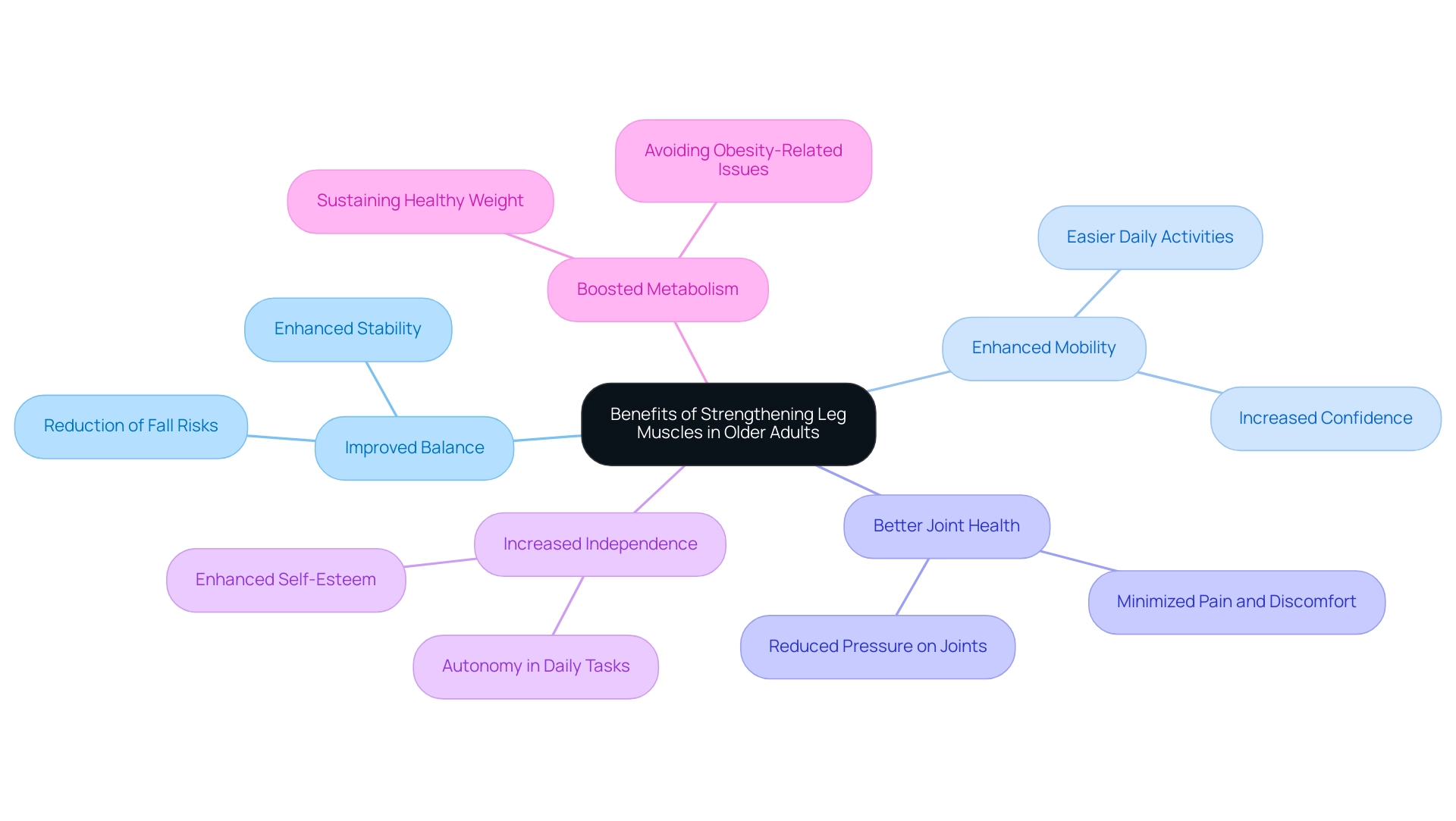Introduction
1. The Importance of Leg Exercises for Seniors

2. Top Leg Exercises for Seniors: A Comprehensive Guide
-
Seated Leg Extensions: This movement involves extending one leg straight out while seated and holding the position for a few seconds before lowering it back down. Seated leg exercises, including leg extensions, are particularly effective for strengthening the quadriceps without imposing stress on the knees, making them suitable for older adults. Considering that participation rates for individuals over 50 are as low as 10% for those over 75, engaging in such activities is crucial for maintaining leg strength.
-
Chair Squats: Positioned in front of a sturdy chair, lower your body as if preparing to sit, then rise back up. This functional activity enhances overall leg strength and stability, which can be improved through leg exercises, and is crucial for maintaining independence and mobility in daily tasks. Strength training, particularly leg exercises like chair squats, has been demonstrated to reduce mortality by 81% and nursing home admissions by 84% in older individuals who underwent surgical repair of osteoporotic hip fractures, highlighting their significance.
-
Calf Raises: Stand with your feet shoulder-width apart and gradually lift your heels off the ground before lowering them back down. This movement specifically targets the calf muscles as part of leg exercises, contributing to improved balance and support while standing or walking.
-
Side Leg Raises: While standing and holding onto a chair for stability, lift one leg straight out to the side and return it to the starting position. This activity includes leg exercises that strengthen the hip abductors, which is essential for maintaining lateral stability and preventing falls.
-
Heel Slides: Lie on your back and slide your heel towards your buttocks, then extend it back out. Heel slides are gentle on the joints while effectively working the hamstrings, making them an excellent choice among leg exercises for aiding in flexibility and mobility.
-
Step-Ups: Using a low step or platform, step up with one foot and then back down. This practical activity includes leg exercises that improve leg power and coordination, which are essential for traversing stairs and uneven terrains.
-
Wall Sits: Lean against a wall and slide down until your knees form a 90-degree angle. Holding this position builds endurance in the leg muscles, which is beneficial for overall lower body strength and can be considered one of the effective leg exercises.
-
Leg Press with Resistance Bands: Sit with a resistance band looped around your feet and push against it to strengthen the legs. This versatile activity allows for leg exercises that can be modified according to personal capability levels, making it suitable for seniors.
-
Lateral Band Walks: With a resistance band placed around the thighs, take side steps to engage the outer thighs and glutes. This activity not only improves strength but also enhances stability and coordination by incorporating leg exercises.
-
Seated Marching: While seated, lift your knees alternately in a marching motion. This low-impact exercise, which includes leg exercises, is excellent for enhancing circulation and mobility, making it a practical choice for seniors seeking to maintain their physical activity levels.

3. Benefits of Strengthening Leg Muscles in Older Adults
-
Improved Balance: Enhanced leg power significantly contributes to better balance, which is critical in reducing the risk of falls—a leading cause of injury among seniors. Considering that around 9,500 fatalities in older American adults are linked to falls annually, enhancing balance through leg power can have life-saving consequences.
-
Enhanced Mobility: Increased leg power from leg exercises facilitates easier movement, empowering seniors to perform daily activities with greater confidence and ease. This enhances not only their physical abilities but also their overall quality of life.
-
Better Joint Health: Performing leg exercises to fortify the muscles around the knees and hips can effectively relieve pressure on these joints, which is essential for minimizing pain and discomfort frequently linked with aging.
- Boosted Metabolism: Muscle mass is integral to metabolic health. Leg exercises contribute to more powerful legs, which aid in sustaining a healthy weight and subsequently assist in avoiding obesity-related problems.
emphasizing that resistance training can be accessible and beneficial for individuals across various fitness levels.

4. Safety Tips for Seniors When Exercising Legs
-
Consult a Healthcare Provider: Prior to commencing any new exercise program, it is crucial for seniors to consult with their healthcare provider to confirm that the chosen activities are appropriate for their specific health circumstances. This step is particularly important given that 71.2% of senior adults with functional limitations report no leisure-time physical activity, as highlighted by NHANES data from 2011-2012. This statistic underscores the barriers many seniors face in engaging in physical activity.
-
Warm-Up and Cool Down: Participating in gentle warm-up and cool-down activities, including leg exercises, is essential for preventing injuries and enhancing flexibility. Research suggests that appropriate warm-up practices can reduce the risk of activity-related injuries, a concern highlighted by Robert M D Little, who stated,Fear of injury is reported as a barrier to physical activity by seniors.
-
Utilize Support: When engaging in activities, using chairs, walls, or other sturdy objects for support aids in maintaining balance and stability. This is particularly important for senior adults, who may encounter heightened risks of falls during physical activity.
-
Start Slow: It is advisable to begin with low-impact leg exercises and incrementally increase the intensity as strength and confidence develop. Evidence from studies, such as those conducted by Colbert LH et al., demonstrates that novice older adults starting physical activity are not at an increased risk of injury, suggesting that a gradual approach can be effective. Additionally, the case study titled "Injury Reporting and Limitations in Older Adult Studies" supports this claim by showing that while injuries can affect daily activities, novice exercisers are not at a higher risk of injury.
-
Listen to Your Body: Seniors should remain attuned to their bodies, paying careful attention to any discomfort or pain. It is vital to stop exercising if necessary and to modify or skip activities that feel unsafe.
-
Stay Hydrated: Maintaining adequate hydration before, during, and after physical activity is crucial for overall health. Proper hydration supports physical performance and recovery, reducing the likelihood of fatigue and related injuries.

5. Using Equipment and Modifications for Effective Leg Workouts
- Resistance Bands: These bands provide an effective means to add resistance to exercises, promoting strength without placing undue stress on the joints. Research shows that resistance band activities provide clinical advantages, particularly for frail seniors, improving their overall physical abilities. As mentioned by John Wiley & Sons Ltd., "As a safe complementary approach for frail older adults, health providers should consider resistance band activities when caring for frail older adults because this intervention has clinical benefits."
- Light Weights: The inclusion of light dumbbells during leg routines enables seniors to develop power gradually. This approach minimizes the risk of overexertion while effectively improving muscle tone and endurance.
- Stability Balls: Utilizing stability balls not only aids in leg exercises but also enhances balance and core stability. This dual benefit is essential for maintaining mobility and stability in daily activities.
- Chair Modifications: Engaging in activities while seated or using a chair for support enhances safety and manageability. This modification is particularly beneficial for those with limited mobility or balance concerns, allowing for a more comfortable workout experience.
- Step Platforms: Low step platforms function as a superb tool for step-up activities, which are essential leg exercises for developing leg power and coordination. These platforms provide a safe method for seniors to engage in functional movements that translate to daily activities.
- Balance Aids: Devices such as balance boards or walking sticks can significantly improve stability during activities, ensuring that seniors can perform movements confidently and safely. These aids not only assist in resistance training but also help in preventing falls, a critical concern among seniors.

Conclusion
- Seated leg extensions
- Chair squats
- Consulting healthcare providers
- Starting with low-impact exercises






























